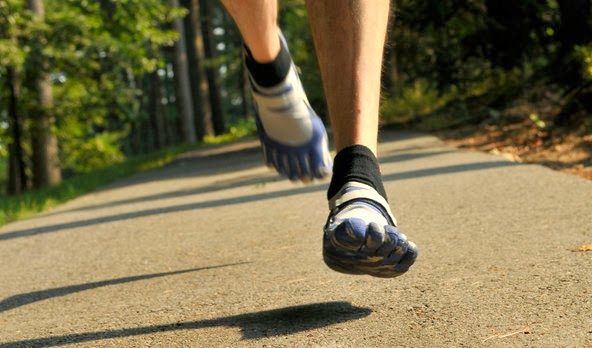The
minimalist fad has seemed to fade into obscurity as quickly as it came
sprinting into everyone’s running program.
The days of seeing ‘Five Finger’ shoes on the streets both on runners
and your everyday person have seemed to pass but does the minimalist/barefoot
technique of running truly hold some merit.
In
an article in Men’s Health, “Barefoot Running Stumbles”, the writer presents
the case well from both sides of the coin.
The foot is an unbelievably complex part of the body consisting of 26
bones, 33 articulations, 111 ligaments, and 20 plus muscles in each foot1. If you think about the amount of motion and
stability occurs over the thousands of steps taken in not only walking a mile
but add the force associated with running it is truly impressive what our feet
can do.
A
study at the University of Wisconsin-La Crosse showed that a forefoot/midfoot
landing in a less heel cushioned shoe increases the load per step by 11% and
that can add up to over 7000 pounds of pressure added to the Achilles per
mile. This is a significant amount of
force and is typically where people new to minimalist running can get
themselves in trouble and injured. Gradual
progression in the key to regulating this this increase in tension and increase
in pressure on the Achilles. The suggestion is that you start at adding
minimalist shoes to only 10% of your mileage to start with and progress from
there1. This is not a case of
“if some is good, more is better”.
Continue on the next page:
While
the chance for injury can increase when making the shift to minimalist or
barefoot there are many advantages to changing to this type of shoe and
adopting a forefoot or midfoot strike.
One study looking at treatment options for exertional anterior
compartment syndrome have found switching to a mid/forefoot strike can reduce
and possibly eliminate the symptoms associated with the problem. For many athletes who suffer from compartment
syndrome that could be the difference in their career. Many people on person accounts have felt a
reduction in back pain due to the reduce heel when just walking around in a
minimalist shoe.
The
effect on performance is also another area of interest and there has been no
definitive literature stating what stride is best for optimal performance. Stanford University has actually adopted the
idea of determining the stride type of their runners and then working to get
the optimal amount of performance out of that stride rate instead of trying change
someone’s natural stride pattern.
The
barefoot/minimalist craze has seemed to come and go but there is merit in
working with this type of training. The
key is to be smart about it and make sure to not go all or nothing.
Please
feel free to contact TAT with any questions regarding barefoot/minimalist
running.
1: Men’s Health September 2013: Barefoot Running Stumbles
–Michael Behar
This Infographic sums up information well:



No comments:
Post a Comment